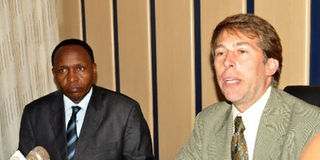More own guns as faith in police wanes

Acting PS for Internal Security, Mutea Iringo (left) and Eric Berman (right) a researcher on small arms, Geneva during a media briefing on the launch of a special report on the National Arms Mapping and Survey on June 20, 2012 at Harambee House. Photo/SALATON NJAU
What you need to know:
- Law enforcers mentioned as accomplices to crime, sometimes hiring out their guns to criminals or working with gunrunners
More than ever before, fear of insecurity is driving Kenyans to own firearms, pushing the demand for illegal guns to a new level.
The findings of a survey commissioned by the government estimated there are between 530,000 and 680,000 guns in the wrong hands. And the demand rising.
Reasons abound as to why Kenya could be awash with illicit firearms, all pointing at the need of ordinary citizens to protect themselves and their property.
Findings of the survey are contained in Availability of Small Arms and Perceptions of Security in Kenya: An Assessment, a report launched by Internal Security permanent secretary Mutea Iringo on Wednesday.
Parts of Western and South Rift Kenya are on the spot after the survey identified them as “emerging zones” where demand for illegal guns is at an all time high.
In these areas, the researchers linked this to next year’s General Election, since residents there fear a repeat of the violence triggered by the 2007 polls.
Several sections of the report, compiled by Small Arms Survey, an organisation based in Geneva, Switzerland and the National Focal Point on Small Arms, support these assertions.
“There is close inter-relationship between insecurity and increased desire for firearms ownership for protection and defensive purposes. For instance there is concern that cycles of electoral violence could be feeding demand for guns in some areas,” part of the report reads.
Another part of the report says: “The election-related violence of 2007/08, mass displacements, and widespread insecurity are believed to have fed a new demand for small arms, especially in central Rift Valley Province. Whereas many crude weapons were used to unleash the violence and resultant killings then, there are reports of communities seeking to acquire — and obtaining — more sophisticated firearms. Alongside this growing demand, are concerns about the potential proliferation of armed groups and the growth of existing organised gangs.”
The arms problem was also noted in Nairobi, Mombasa, Eldoret and other major towns, but the town dwellers were more worried of criminal gangs that commit robberies, thus feeling the need to protect themselves.
This is attributed to “failure of the police to stamp out the problem, contributing to increasing public disillusionment.” The ongoing security sector reforms are seen as integral part of correcting the malpractice.
“In handling ongoing reforms, emphasis should be put on strengthening the public’s confidence in law enforcement agencies, improving the efficiency and accountability of the security forces, and strengthening institutional frameworks for government-civic partnership in security management.
“The victimisation part in this survey revealed a considerable amount of lack of confidence in the security forces,” the report also says.
The police are also mentioned as accomplices to crime, sometimes hiring out their guns to criminals or working in cohorts with gunrunners.
“In the Rift Valley Province, respondents talked of a known gunrunner who uses private transport in trafficking arms from Garissa to Nakuru. Sometimes the arms are concealed in sugar or other consignments. It was in Nakuru, Samburu, and Trans-Nzoia that the strongest suspicions of some police officers’ complicity in crimes emerged,” according to the report.
And to ensure this vice is checked, the researchers have proposed that all government-owned arms, those in police, military, Kenya Wildlife Service, and the Forest guards, be “test fired to collect their ballistic information.”
The exercise would be extended to include civilians licensed to carry firearms.
The ballistic information would be stored in a national database that would be referred to every time there is an investigation on gun-related incidents.
Normally, every gun fired leaves marks that are unique to it just like there are fingerprints in humans.
The bulk of illicit firearms in Kenya is held by pastoral communities in Upper Eastern and North Rifts parts of Kenya. Most of them who say the weapons are necessary to protect their livestock.
“Livestock rustling and inter-ethnic conflicts still persist in northern Kenya, and this feeds the quest for arms, since it builds communities’ self-defence capabilities.
In the North Rift region, pastoralist communities are often locked in intense resource-based conflicts as groups seek to access and control water and pasture,” the report explains.
The document also faults past forced disarmaments in Operation Chunga Mpaka and Operation Dumisha Amani, saying illicit guns were still in plenty in Mt Elgon and Mandera, where the exercises were conducted respectively.
The researchers also identified 26 routes used by traffickers to transport illegal weapons.
Main sources of firearms are Somalia, South Sudan, Uganda and Ethiopia but ammunitions are also smuggled from government security agencies within Kenya.
Police officers are accused of sneaking bullets from training fields.
In Samburu, the report notes: “There were concerns about uncollected British Army munitions, with claims that some community members get arms and ammunition from British Army training camps. Some are given as presents after completion of training and on some occasions caches of ammunition are sold at very low prices.”




